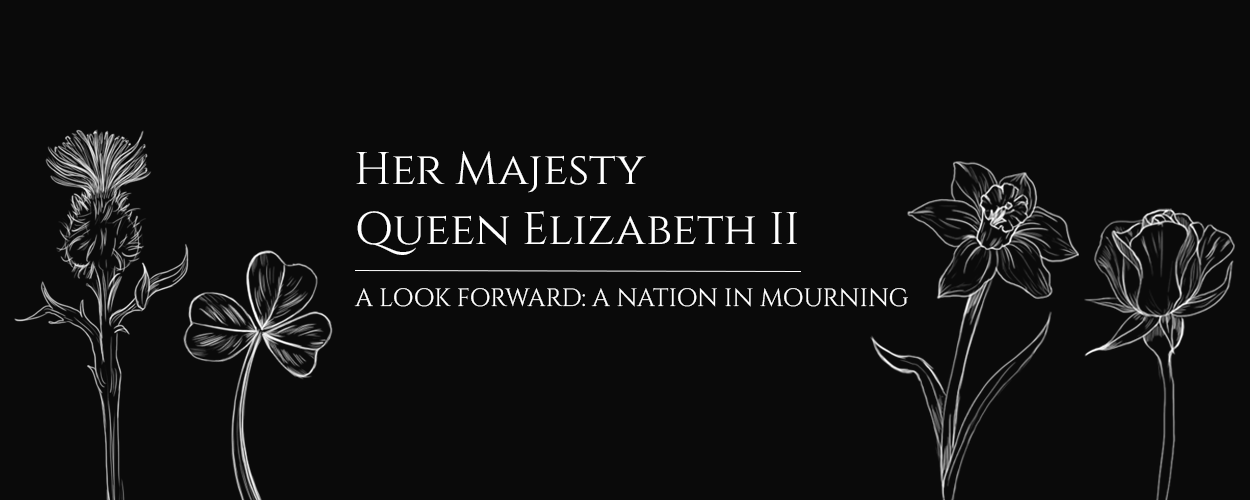On 8th September 2022, it was announced that Her Majesty Queen Elizabeth II had passed away at her residence in Balmoral. In the aftermath of such a momentous announcement, many people in the UK and across the Commonwealth will be mourning the loss of Britain’s longest-reigning monarch. However, just as many people are likely to be wondering what happens next.
Operations London Bridge, Unicorn, and Spring Tide
The death of Her Majesty the Queen has meant several special plans have come into effect. The most famous of these is Operation London Bridge, a series of protocols that dictate how the country – namely the media and government – are expected to handle the news of her passing and what happens next.
However, as the Queen passed away in Scotland, there is a secondary protocol that must be followed alongside Operation London Bridge. This is Operation Unicorn – so named because Scotland’s national animal is the unicorn. According to this protocol, parliamentary business must be immediately suspended to allow authorities to prepare for the Queen’s funeral.
The Queen will temporarily lie at rest in St Giles’ Cathedral in Edinburgh before being transported to London in preparation for her state funeral. According to what we know about Operation Unicorn, the Queen will be flown to London after a few days.
Operation London Bridge is the main plan in the event of the Queen’s death. It operates alongside Operation Unicorn and takes precedence once the Queen is returned to London. Upon her passing, the information was delivered to the Prime Minister, civil servants, and the heads of the Commonwealth countries – beginning with those for whom Her Majesty the Queen was Head of State.
An official notification was posted upon the gates of Buckingham Palace and the flag over the palace was flown as half-mast. It will continue to fly at half-mast throughout the period of mourning, which will conclude seven days after the Queen’s funeral. The Queen will lie in state for three days at Westminster before her funeral.
Operation Spring Tide is the plan for King Charles III’s ascension to the throne. It involves the official proclamation, swearing of allegiance, and a tour of the United Kingdom before HM the Queen’s funeral.
Flags at Half-Mast and Presenters Wearing Black
As news of Her Majesty the Queen’s death was passed to national media, steps were taken in accordance with Operation London Bridge. Newscasters switched to black clothing and television schedules were adjusted. Flags across the country – most notably atop Buckingham Palace – are being flown at half-mast in recognition of Her Majesty’s passing.
Official statements were also released by His Majesty King Charles III and Prime Minister Liz Truss.
In recognition of this occasion, many programmes will no longer be broadcast this weekend. Sporting fixtures have also been called off as a mark of respect, including on Monday.
When is Her Majesty’s Funeral?
The date of the funeral has been announced as Monday 19th September. It will be a bank holiday, and an official Day of Mourning. During the preceding week, Her Majesty will lie in state first in Edinburgh, until 13th September when she will be transported to London.
Once Her Majesty the Queen has been returned to London, she will then lie in state at Westminster Abbey. Her Majesty’s coffin will be viewable from the 14th until the 18th September. Members of the public are welcomed to pay their respects to the Queen, though long queues are expected.
A memorial service was held at St Paul’s Cathedral on Friday 9th September, which was attended by the Prime Minister and other senior government officials. When Her Majesty arrives at Westminster Abbey, the royal family will attend a short service before the Abbey is opened to the public.
Where Will Her Majesty Be Buried?
The funeral service will take place at Westminster Abbey, and will be attended by the Royal Family, heads of state from across the world, senior politicians, and former prime ministers. Following the service, the Queen will be transported from Westminster Abbey to St George’s Chapel at Windsor Castle. Here, there will be a second, committal service, which will see Queen Elizabeth II interred in the royal vault. She is expected to be placed alongside her late husband, Prince Philip, and her father, King George VI.
His Majesty King Charles III
The death of Her Majesty Queen Elizabeth II has meant that the crown has been passed to her eldest son and heir, Charles. This means that, effective immediately, he is no longer Prince of Wales and is now King of the United Kingdom.
However, before he is crowned there are several formalities that must be undertaken.
His Majesty’s first decision was what name he would take as King. This is known as a Regnal Name. Famously, King George VI was raised as Prince Albert before choosing to be King George. A newly acceded monarch can choose any of their own names. King Charles’ full name is Charles Philip Arthur George. As such, he could have chosen to be King Philip, Arthur, or George VII. He has chosen to be King Charles III.
His wife, Camilla Parker-Bowles, has now been given the title of Queen Consort.
A speech from King Charles III was delivered at 6pm on Friday 9th September.
The formal proclamation of Charles as King was televised on Saturday 10th September. It was performed with the Accession Council, which consisted of senior government officials. Following a second meeting, in which King Charles made a declaration of his duties to the United Kingdom, he was publicly proclaimed King.
When Is The Coronation?
Much preparation is required before King Charles III can be officially crowned King. Though he will hold the title, the coronation is not likely to occur until 2023. When Her Majesty Elizabeth II was named Queen in February 1952, the coronation did not take place until June of the next year.
When the coronation takes place, it is likely to be held in Westminster Abbey, a tradition that has been upheld since William the Conqueror was crowned there over 900 years ago. Charles will be the 40th monarch to be crowned there.
The ceremony will be carried out by the Archbishop of Canterbury. His Majesty will take his oath before being crowned King of the United Kingdom.
Who Is The New Head of the Commonwealth
Before her passing, in 2018, Her Majesty Queen Elizabeth II announced that she wished for King Charles III to succeed her as Head of the Commonwealth. There are currently 56 nations in the Commonwealth, of which 14, as well as the UK, have the King as head of state.
What Happens to Postage Stamps and Money?
Her Majesty the Queen’s likeness is a prominent feature in our society. She adorns postage stamps, coins, and banknotes. Fortunately, these will all remain legal tender. New stamps and coins will be introduced gradually once designs have been approved.
Current banknotes and coins will be phased out with the introduction of new coins, but you will not need to exchange your currency unless the Bank of England say otherwise – you will be given plenty of notice if this is the case. Instead, coins and banknotes with His Majesty’s likeness will be introduced to circulation and older coins removed through normal financial transactions.
Prior to decimalisation in 1971, coins often had various monarchs on them from different reigns. It was only with the system change during Her Majesty’s reign that all coins bore the same face.
When King Charles III is printed on future coins, he will face in the opposite direction to Her Majesty, as tradition demands.
Similarly, Royal Mail will stop producing stamps featuring the profile of HM Queen Elizabeth II, and new stamps featuring HM King Charles III will be printed instead. Furthermore, any new post boxes installed will now bear the King’s new cipher, as opposed to EIIR, which represented Her Majesty the Queen.
Passports will also undergo a change. Whilst all current passports will remain valid, new passports will be issued in the name of His Majesty.
The royal cipher on police helmets will now change, and, effective immediately, barristers and solicitors appointed to be Queen’s Counsel are now known as the King’s Counsel.
If you have any questions relating to the coming days, please leave our team a comment below.
Choose Your Personal Alarm
To help you choose, start by selecting where you would use your personal alarm. In home only or at home and on the go.













Leave a Reply